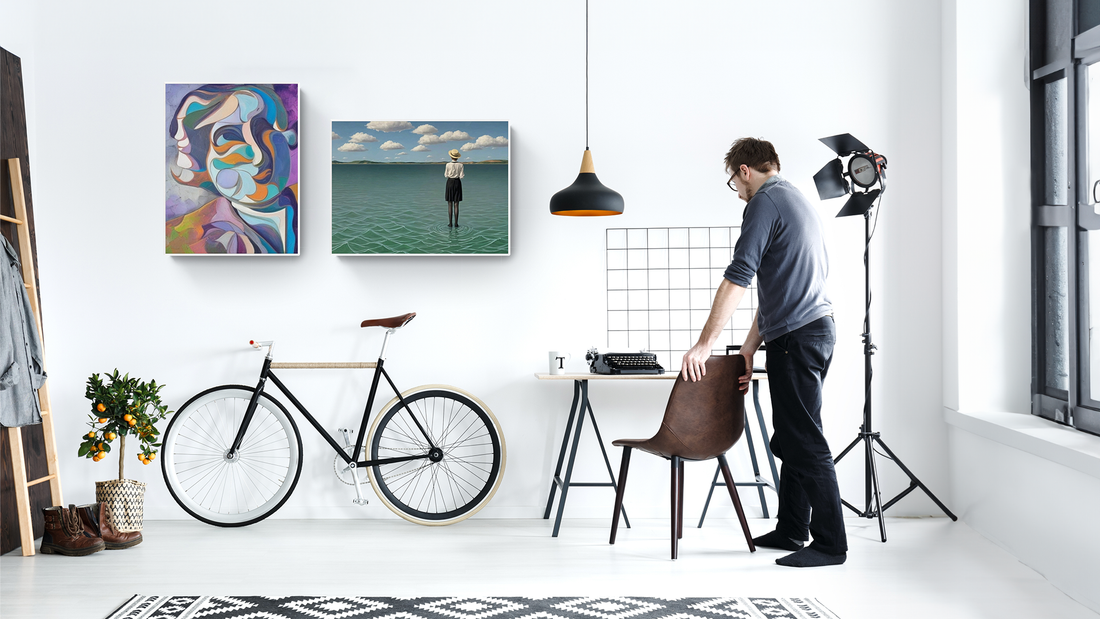
What’s The Difference Between Modern and Contemporary Art?
Modern Art and Contemporary Art are often confused or used interchangeably. They share some similarities, but also differ in historical context, philosophy, and techniques. Knowing the difference builds up your art appreciation and helps you choose the right artwork for your space.
What is Modern Art?
Modern Art developed in the late 19th century, from the 1860s to the 1970s. It was a response to rapid industrialization, social changes, and global conflicts.
Key Characteristics:
-
Break from tradition
Focused on new artistic techniques, breaking away from classical realism.
-
Experimentation
Pioneered movements like Cubism, Surrealism, and Abstract Expressionism.
-
Emphasis on abstraction
Artists like Picasso and Kandinsky experimented with shapes, color, and form, moving away from realistic depictions.
Notable Modern Artists & Works:
- Pablo Picasso - Les Demoiselles d'Avignon (1907, France)
- Claude Monet - Water Lilies (1919, France)
-
Jackson Pollock - No. 5, 1948 (1948, USA)
What is Contemporary Art?
Contemporary Art began in the 1970s and continues today, often reflecting current social, political, and technological contexts.
Key Characteristics:
-
Focus on present issues
Engages with topics like identity, technology, and globalization.
-
Diverse mediums
Incorporates digital art, performance, and mixed media.
-
Conceptual focus
Art is often more about the idea than the object itself.
Notable Contemporary Artists & Works:
- Yayoi Kusama - Infinity Mirrored Room (2013, USA)
- Banksy - Girl with Balloon (2002, UK)
- Damien Hirst - The Physical Impossibility of Death in the Mind of Someone Living (1991, UK)
Key Differences Between Modern and Contemporary Art
Despite their distinct timelines and approaches, Modern and Contemporary Art share common ground in their spirit of innovation. Both periods emphasize pushing boundaries and experimenting with new forms and techniques
Here’s a comparison of the most important differences between these two movements:
|
Modern Art |
Contemporary Art |
Overlap |
|
|
Time Period |
1860s to 1970s |
1970s to present |
Some transitional artists, like Andy Warhol, span both movements. |
|
Artists |
Pablo Picasso, Vincent van Gogh, Claude Monet |
Yayoi Kusama |
Artists like Andy Warhol and David Hockney bridge both periods |
|
Philosophy |
Focused on human experience, emotions, and abstraction. |
Conceptual, addressing current societal and global issues. |
Both push artistic boundaries, questioning the nature of art itself. |
|
Mediums Used |
Traditional media like painting and sculpture. |
Digital, multimedia, installation, and performance art. |
Both movements embrace innovation and experimentation in form. |
|
Intent |
Aimed to break from classical traditions, depicting emotions and modern life. |
Often challenges societal norms and questions the role of art. |
Both emphasize individual expression and rebellion against conventions. |
Why It Matters for Collectors and Enthusiasts
Understanding the difference between Modern and Contemporary Art is not just an academic exercise. Whether you’re a collector or simply looking for the perfect piece for your home, recognizing these distinctions helps you make better choices.
Modern Art prints can add a timeless, abstract quality to your space, with works that focus on emotion and experimentation. Contemporary Art pieces, on the other hand, often serve as conversation starters, bringing bold, innovative ideas that challenge traditional notions of art and society.
If you’re considering adding wall art to your home or office, knowing these differences allows you to choose a piece that reflects your personal taste and the ambiance you want to create.



